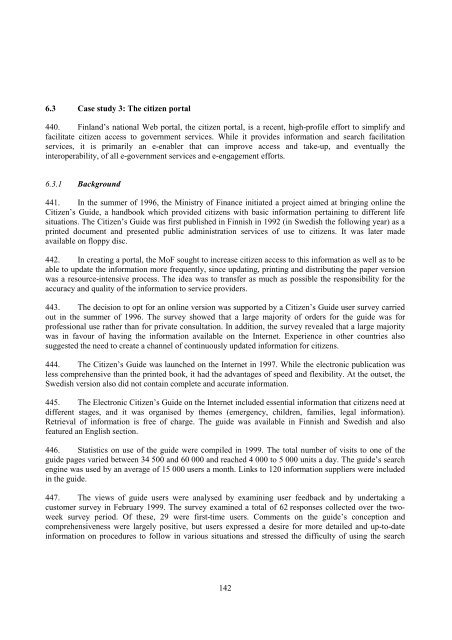e-GOVERNMENT IN FINLAND - ePractice.eu
e-GOVERNMENT IN FINLAND - ePractice.eu
e-GOVERNMENT IN FINLAND - ePractice.eu
Create successful ePaper yourself
Turn your PDF publications into a flip-book with our unique Google optimized e-Paper software.
6.3 Case study 3: The citizen portal<br />
440. Finland’s national Web portal, the citizen portal, is a recent, high-profile effort to simplify and<br />
facilitate citizen access to government services. While it provides information and search facilitation<br />
services, it is primarily an e-enabler that can improve access and take-up, and eventually the<br />
interoperability, of all e-government services and e-engagement efforts.<br />
6.3.1 Background<br />
441. In the summer of 1996, the Ministry of Finance initiated a project aimed at bringing online the<br />
Citizen’s Guide, a handbook which provided citizens with basic information pertaining to different life<br />
situations. The Citizen’s Guide was first published in Finnish in 1992 (in Swedish the following year) as a<br />
printed document and presented public administration services of use to citizens. It was later made<br />
available on floppy disc.<br />
442. In creating a portal, the MoF sought to increase citizen access to this information as well as to be<br />
able to update the information more frequently, since updating, printing and distributing the paper version<br />
was a resource-intensive process. The idea was to transfer as much as possible the responsibility for the<br />
accuracy and quality of the information to service providers.<br />
443. The decision to opt for an online version was supported by a Citizen’s Guide user survey carried<br />
out in the summer of 1996. The survey showed that a large majority of orders for the guide was for<br />
professional use rather than for private consultation. In addition, the survey revealed that a large majority<br />
was in favour of having the information available on the Internet. Experience in other countries also<br />
suggested the need to create a channel of continuously updated information for citizens.<br />
444. The Citizen’s Guide was launched on the Internet in 1997. While the electronic publication was<br />
less comprehensive than the printed book, it had the advantages of speed and flexibility. At the outset, the<br />
Swedish version also did not contain complete and accurate information.<br />
445. The Electronic Citizen’s Guide on the Internet included essential information that citizens need at<br />
different stages, and it was organised by themes (emergency, children, families, legal information).<br />
Retrieval of information is free of charge. The guide was available in Finnish and Swedish and also<br />
featured an English section.<br />
446. Statistics on use of the guide were compiled in 1999. The total number of visits to one of the<br />
guide pages varied between 34 500 and 60 000 and reached 4 000 to 5 000 units a day. The guide’s search<br />
engine was used by an average of 15 000 users a month. Links to 120 information suppliers were included<br />
in the guide.<br />
447. The views of guide users were analysed by examining user feedback and by undertaking a<br />
customer survey in February 1999. The survey examined a total of 62 responses collected over the twoweek<br />
survey period. Of these, 29 were first-time users. Comments on the guide’s conception and<br />
comprehensiveness were largely positive, but users expressed a desire for more detailed and up-to-date<br />
information on procedures to follow in various situations and stressed the difficulty of using the search<br />
142
















